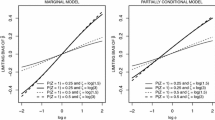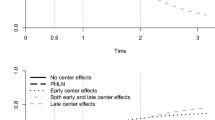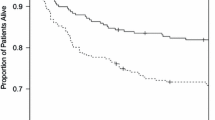Abstract
In this article, we develop methods for quantifying center effects with respect to recurrent event data. In the models of interest, center effects are assumed to act multiplicatively on the recurrent event rate function. When the number of centers is large, traditional estimation methods that treat centers as categorical variables have many parameters and are sometimes not feasible to implement, especially with large numbers of distinct recurrent event times. We propose a new estimation method for center effects which avoids including indicator variables for centers. We then show that center effects can be consistently estimated by the center-specific ratio of observed to expected cumulative numbers of events. We also consider the case where the recurrent event sequence can be stopped permanently by a terminating event. Large-sample results are developed for the proposed estimators. We assess the finite-sample properties of the proposed estimators through simulation studies. The methods are then applied to national hospital admissions data for end stage renal disease patients.

Similar content being viewed by others
References
Agresti A, Hartzel J (2000) Strategies for comparing treatment on a binary response with multicentre data. Stat Med 19:1115–1139
Cook R, Lawless J (1997) Marginal analysis of recurrent events and a terminal event. Stat Med 16:911–924
Efron B (2004) Large-scale simultaneous hypothesis testing: the choice of a null hypotheses. J Am Stat Assoc 99:96–104
Glidden DV, Vittinghoff E (2004) Modelling clustered survival data from multicentre clinical trials. Stat Med 23:369–388
Gould A (1998) Multi-centre trial analysis revisited. Stat Med 17:1779–1797
Kalbfleisch JD, Prentice RL (2002) The Statistical analysis of failure time data, 2nd edn. Wiley, New York
Lin D, Wei L, Yang I, Ying Z (2000) Semiparametric regression for the mean and rate functions of recurrent events. J R Stat Soc B 62:730–771
Localio A, Berlin J, Ten Have T, Kimmel S (2001) Adjustments for centre in multicentre studies: an overview. Ann Interval Medicine 135:112–123
Schaubel D, Cai J (2005) Analysis of clustered recurrent event data with application to hospitalization rates among renal failure patients. Biostatistics 6:404–419
Schaubel D, Cai J (2005) Semiparametric methods for clustered recurrent event data. Lifetime Data Anal 11:405–425
Spiegelhalter D, Sherlaw-Johnson C, Bardsley M, Blunt I, Wood C, Grigg O (2012) Statistical methods for healthcare regulation: rating screening and surveillance (with discussion). J R Stat Soc A 175:1–25
Ye Y, Kalbfleisch J, Schaubel D (2007) Semiparametric analysis of correlated recurrent and terminal events. Biometrics 63:78–87
Acknowledgements
The authors wish to thank Tempie Hulbert-Shearon, Valarie Ashby and Flannery Campbell of the University of Michigan Kidney Epidemiology and Cost Center (KECC) for their assistance with the data analysis. This work was supported in part by contract M000336 from the Centers for Medicare and Medicaid Services (CMS) and a grant 5R01 DK070869 from the National Institutes of Health.
Author information
Authors and Affiliations
Corresponding author
Appendix
Appendix
1.1 Consistency of \(\widehat{\mu}_{0}(\widehat{\boldsymbol{\beta}},t)\)
Let \(\phi_{0}(t)=\widehat{\mu}_{0}(\widehat{\boldsymbol{\beta}},t) -\mu_{0}(t)=\phi_{1}(t)+\phi_{2}(t)\), where \(\phi_{1}(t)=\widehat{\mu}_{0}(\widehat{\boldsymbol{\beta}},t) -\widehat{\mu}_{0}(\boldsymbol{\beta},t)\) and \(\phi_{2}(t)=\widehat{\mu}_{0}(\boldsymbol{\beta}_{0},t) -\mu_{0}(t)\). By the triangle inequality,

A Taylor series expansion of
yields
where β † lies in the line segment between \(\widehat{\boldsymbol{\beta}}\) and β 0, and \(H(\boldsymbol{\beta}, t)=n^{-1}\sum_{i=1}^{n} H_{i}(\boldsymbol{\beta}, t)\) and
Since N ik (s), \(\mathbf{S}_{k}^{(1)}(\boldsymbol{\beta}, s)\) are bounded and \(\mathbf{S}_{k}^{(0)}(\boldsymbol{\beta}, s)\) is bounded away from 0 for \(\boldsymbol{\beta}\in \mathcal{B}\) and s∈[0,τ] as n→∞, it follows that \(H(\boldsymbol{\beta}, t)=n^{-1}\sum_{i=1}^{n} H_{i}(\boldsymbol{\beta}, t)\) is bounded for sufficiently large n. Since \(\widehat{\boldsymbol{\beta}} \stackrel{\mathrm{a.s.}}{\longrightarrow} \boldsymbol{\beta}_{0}\) as n→∞, it follows that

Further, since \(\sum_{k=1}^{K} w_{k} \theta_{k}=1\), we find

Since \(\mathbf{S}_{k}^{(0)}(\boldsymbol{\beta}_{0}, s)\) is bounded away from 0 and \(n^{-1}\sum_{i=1}^{n} \sum_{k=1}^{K} M_{ik}(\boldsymbol{\beta}_{0}, s)\stackrel{\mathrm{a.s.}}{\longrightarrow} 0\) by the Strong Law of Large Numbers (SLLN) as n→∞ for s∈[0,τ], we have

The uniform consistency of \(\widehat{\mu}_{0}(\widehat{\boldsymbol{\beta}}, t)\) follows from (13), (14), and (15).
1.2 Weak Convergence of \(\widehat{\mu}_{0}(\widehat{\boldsymbol{\beta}},t)\)
We now consider the process n 1/2 ϕ 0(t)=n 1/2 ϕ 1(t)+n 1/2 ϕ 2(t). We see that

where \(\widehat{\varPsi}_{2i}(\boldsymbol{\beta}_{0}, t)=\sum_{k=1}^{K} w_{k} \int_{0}^{t} \mathbf{S}_{k}^{(0)}(\boldsymbol{\beta}_{0}, s)^{-1}\,dM_{ik}(\boldsymbol{\beta}_{0}, s)\).
Under conditions (a)–(g), it follows that \(\sup_{t \in [0, \tau]} |\widehat{\mu}_{0k}(\widehat{\boldsymbol{\beta}}, t) -\mu_{0k}(t)|\stackrel{\mathrm{a.s.}}{\longrightarrow} 0\), k=1,…,K, and \(H(\boldsymbol{\beta}_{0}, t) \stackrel{\mathrm{a.s.}}{\longrightarrow} h(\boldsymbol{\beta}_{0}, t)\) for t∈[0,τ].
The partial likelihood score equation (6) can be written as

Under condition (e), \(\widehat{\varPsi}_{1i}(\boldsymbol{\beta})\) converges to Ψ 1i (β) for i=1,…,n. A Taylor series expansion of the score equation at \(\boldsymbol{\beta}=\widehat{\boldsymbol{\beta}}\) around β 0 yields

As n→∞, \(n^{-1}\widehat{I}(\boldsymbol{\beta}_{0})\stackrel{\mathrm{a.s.}}{\longrightarrow} \mathbf{A}\), where A is the positive definite matrix defined in condition (h). We can see that

Under condition (e), \(\widehat{\varPsi}_{2i}(\boldsymbol{\beta}_{0}, t)\) converges to Ψ 2i (β 0,t) for i=1,…,n. Hence

Combining (16) and (17), we see that \(n^{1/2}\phi_{0}(t)=n^{-1/2} \sum_{i=1}^{n} \varPhi_{i}(\boldsymbol{\beta}_{0}, t)+o_{p}(1)\), which converges weakly to a Gaussian Process with covariance function ξ.
1.3 Consistency of \(\widehat{\theta}_{k}\)
From (8),

With the uniform consistency of \(\widehat{\boldsymbol{\beta}}\) and \(\widehat{\mu}_{0}(\widehat{\boldsymbol{\beta}},t)\) as n→∞,

In addition,

by the SLLN as n→∞. Hence the numerator in (18) converges almost surely to 0 as n→∞. With the boundedness condition (c) and (e), the denominator in (18) is also bounded. Hence,
1.4 Weak convergence of \(\widehat{\theta}_{k}\)
Let \(\zeta_{k}=\theta_{k}^{-1}\) and \(\widehat{\zeta}_{k}=\widehat{\theta}_{k}^{-1}\) for k=1,…,K. In the following, we will first show the asymptotic approximation of \(n^{1/2}(\widehat{\zeta}_{k}-\eta_{k})\) and then use the delta method to obtain the asymptotic properties for \(n^{1/2}(\widehat{\theta}_{k}-\theta_{k})\). Since

\(n^{1/2}(\widehat{\eta}_{k}-\eta_{k})\) can be decomposed into three terms as

A Taylor series expansion of the first term of the right-hand side of equation (19) equals
where β † is on the line segment between \(\widehat{\boldsymbol{\beta}}\) and β 0. With the results in (7), condition (e) and the uniform consistency of \(\widehat{\boldsymbol{\beta}}\) and \(\widehat{\mu}_{0}(\widehat{\boldsymbol{\beta}}, t)\), the first term of the right-hand side of equation (19) equals

With the results in (7) and condition (e), the second term of the right-hand side of equation (19) equals

The third term of the right-hand side of equation (19) equals

Combining (19), (20), (21), and (22), we see that
Therefore, \(n^{1/2}(\widehat{\eta}_{k}-\eta_{k})\) converges in distribution to a normal variable with mean 0 and variance is asymptotically E{ζ 4 Γ ki (β 0)2}. Since \(\widehat{\theta}_{k}=1/\widehat{\zeta}_{k}\), applying the delta method, we see that \(n^{1/2}(\widehat{\theta}_{k}-\theta_{k})\) is asymptotically normally distributed with mean 0 and covariance Σ k =E{Γ ki (β 0)2}.
Rights and permissions
About this article
Cite this article
Liu, D., Kalbfleisch, J.D. & Schaubel, D.E. Methods for Estimating Center Effects on Recurrent Events. Stat Biosci 6, 19–37 (2014). https://doi.org/10.1007/s12561-012-9075-4
Received:
Accepted:
Published:
Issue Date:
DOI: https://doi.org/10.1007/s12561-012-9075-4




